


Lacework FortiCNAPP and Arctic Wolf Managed Risk cater to cloud security and risk management sectors, respectively. Lacework FortiCNAPP is favored for its competitive pricing and robust support, whereas Arctic Wolf Managed Risk excels in risk-focused solutions.
Features: Lacework FortiCNAPP offers advanced cloud-native security with comprehensive threat detection and compliance capabilities. Arctic Wolf Managed Risk provides proactive threat detection, continuous monitoring, and a strong focus on risk management strategies.
Room for Improvement: Lacework FortiCNAPP could enhance its vulnerability management and expand integration capabilities. Arctic Wolf Managed Risk may improve by offering mitigation solutions, reducing false positives, and streamlining its interface for better user experience.
Ease of Deployment and Customer Service: Lacework FortiCNAPP features easy cloud integration and responsive customer service. Arctic Wolf Managed Risk is straightforward to deploy with a focus on managed risk services, offering excellent support through proactive managed services.
Pricing and ROI: Lacework FortiCNAPP is cost-effective, providing clear ROI for cloud-focused businesses. Arctic Wolf Managed Risk, while more expensive, delivers substantial ROI with its risk-centered benefits.



Zafran Security integrates with existing security tools to identify and mitigate vulnerabilities effectively, proving that most critical vulnerabilities are not exploitable, optimizing threat management.
Zafran Security introduces an innovative operating model for managing security threats and vulnerabilities. By leveraging the threat exposure management platform, it pinpoints and prioritizes exploitable vulnerabilities, reducing risk through immediate remediation. This platform enhances your hybrid cloud security by normalizing vulnerability signals and integrating specific IT context data, such as CVE runtime presence and internet asset reachability, into its analysis. No longer reliant on patch windows, Zafran Security allows you to manage risks actively.
What are the key features of Zafran Security?
What benefits can users expect from Zafran Security?
In industries where security is paramount, such as finance and healthcare, Zafran Security provides invaluable protection by ensuring that only exploitable vulnerabilities are addressed. It allows entities to maintain robust security measures while allocating resources efficiently, fitting seamlessly into existing security strategies.
Delivered by security experts - Concierge Security® Team; the Arctic Wolf® Managed Risk solution enables you to define and contextualize your attack surface coverage across your networks, endpoints, and cloud environments; provides you with the risk priorities in your environment; and advises you on your remediation actions to ensure that you are benchmarking against configuration best practices and continually hardening your security posture.
Lacework FortiCNAPP provides robust cloud security, combining vulnerability management and multi-cloud insight with user-friendly controls, machine learning detection, and compliance support.
Lacework FortiCNAPP specializes in cloud security by merging machine learning anomaly detection with agent-based vulnerability management to offer detailed alerts and compliance reports. Its comprehensive approach allows continuous monitoring across AWS and Kubernetes, providing insights from an attacker's perspective. The platform offers automation and seamless Slack integration, facilitating collaborative and efficient cloud security management. Users value its ability to handle multi-cloud environments and scan IAC scripts, configurations, and compute nodes across AWS and GCP.
What are the key features?Organizations across sectors leverage Lacework FortiCNAPP for cloud security, focusing on compliance, security posture, and vulnerability management. It is widely used for monitoring AWS and Kubernetes environments, scanning IAC scripts, configurations, and securing compute nodes. It supports multi-cloud security posture management and log ingestion, enabling companies to maintain strong cloud infrastructures without dedicated security layers.
We monitor all Vulnerability Management reviews to prevent fraudulent reviews and keep review quality high. We do not post reviews by company employees or direct competitors. We validate each review for authenticity via cross-reference with LinkedIn, and personal follow-up with the reviewer when necessary.